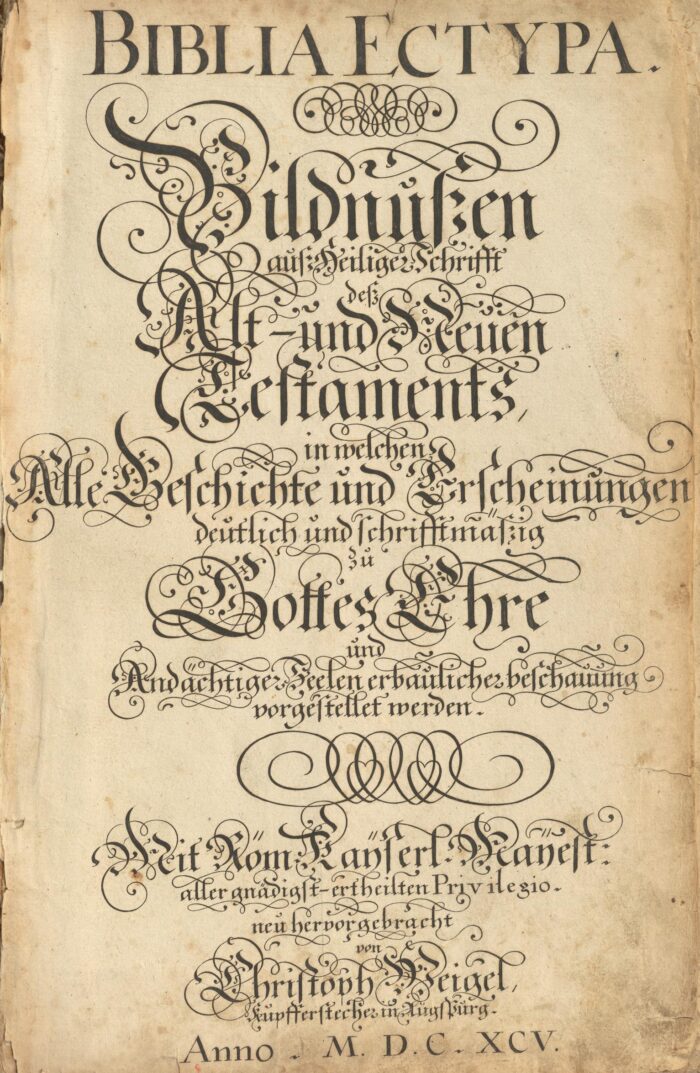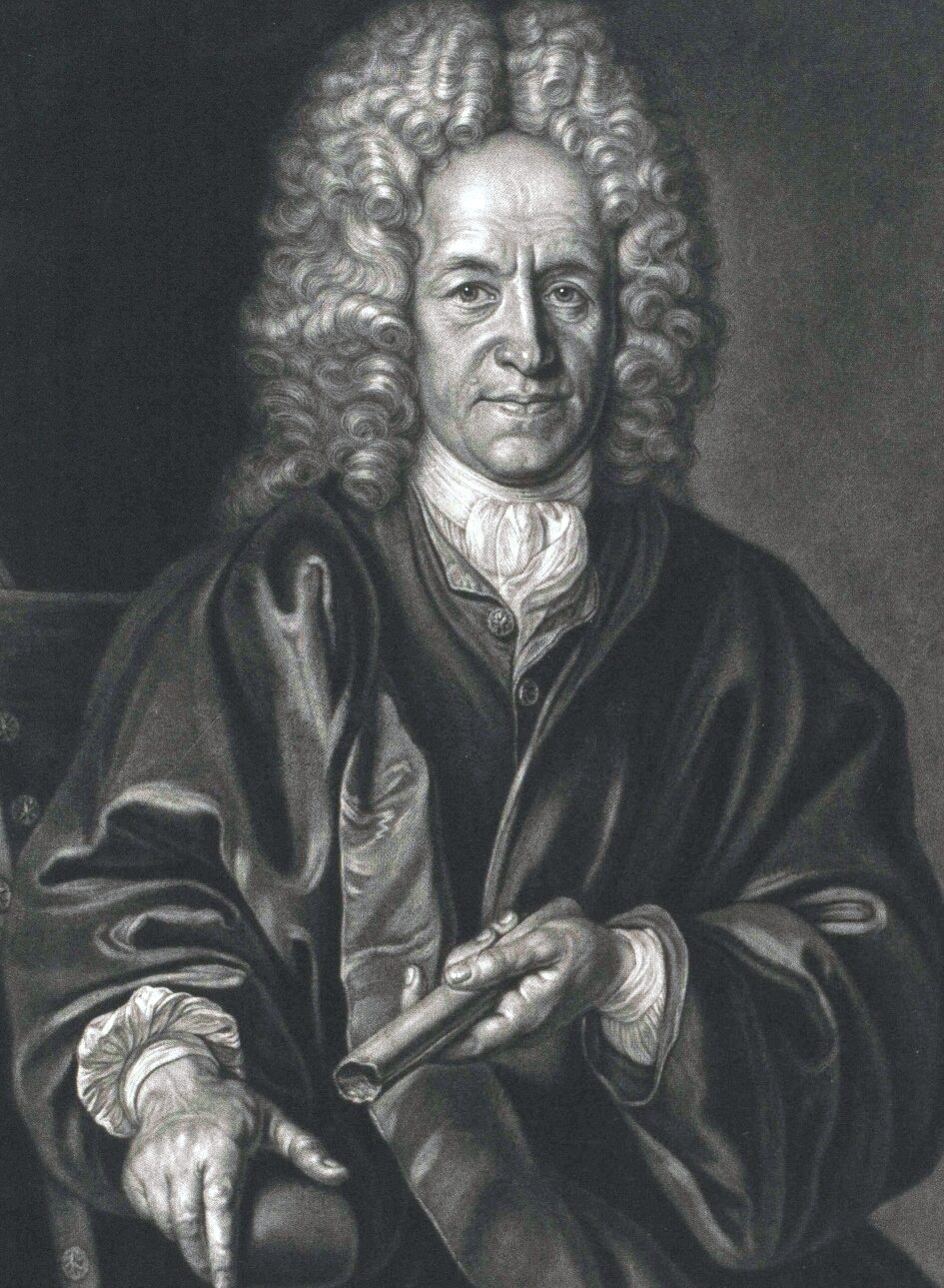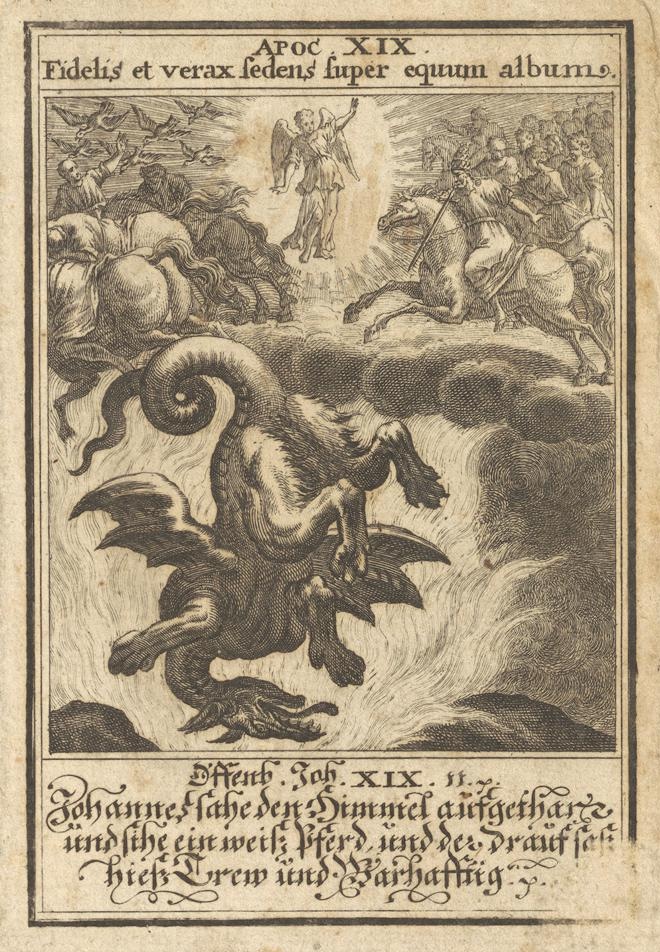The Biblia Ectypa
The Biblia Ectypa
and Chapter 19 of the Book of Revelation
By Fernanda Garcia & Kyle Inducil

| Bibliographic Description | |
| Title | Biblia Ectypa: Bildnussen auß Heiliger Schrifft dess Alt- und Neuen Testaments, in welchen Alle Geschichte und Erscheinungen deutlich und schrifftmäßig zu Gottes Ehre und Andächtiger Seelen erbaulicher beschauung vorgestellet werden |
| Author | Christoph Weigel |
| Date | 1695 |
| Place | Augsberg, Germany |
| Language | German |
| Location | Badische Landesbibliothek (BLB) |
Our Project
Our project focuses on the Biblia Ectypa, created by Christoph Weigel and published in 1695. This graphical Bible does not present its story in words but with engravings. The project specifically explores the engraving that is associated with chapter 19 of the book of Revelation, elaborating on the visual related to the textual content in the chapter. Through exploring the historical context of Biblia Ectypa and integrating Biblical exegesis with visual analysis, this project shows how Christoph Weigel’s artistry uncovers the theological and eschatological significance of this climactic chapter. In the final analysis, it shows how scripture and visual culture cooperate in giving voice to the themes of triumph, justice, and divine authority that define Revelation’s apocalyptic vision.
About the Biblia Ectypa
The Biblia Ectypa is a book of engravings representing a scene or theme in the Bible, both from the Old and New Testaments. The engravings are accompanied by short epigrams or inscriptions about the events depicted. They reflect intricate detail and dramatic flair of the Baroque art, which is full of symbolism and destined for emotional and spiritual reactions. Every image is a combination of symbolic imagery and interpretive text – combining theology with artistic expression. The purpose of the Biblia Ectypa revolves around serving like a devotion tool, meant to light the way into meditation and contemplation of biblical themes with the help of visuals and accompanying texts. By focusing on imagery, the Biblia Ectypa gives access to biblical stories to those who may be less literate or more visually oriented.
About the Author
Christoph Weigel (1654–1725) was a notable German engraver, publisher, and cartographer. He is best known for his detailed engravings, maps, and illustrated books, which often corresponded to the demands of both artistic and cognitive values. His works are highly valued for their historical and artistic significance.
Undoubtedly his most well-known printed publications are the illustrated Bibles and emblematic books, including his Biblia Ectypa covered here, which stands out as a visual narrative of biblical stories. Abbildung der gemein-nützlichen Haupt-Stände (1698) was a comprehensive book showing different professions and trades in minute detail during the 17th century. In addition, there is Historiae celebriores Veteris [Novi] Testamenti iconibus repraesentatae et ad excitandas bonas meditationes selectis epigrammatibus exornatae (1708), a pictorial and meditative exploration of biblical stories. Weigel also ventured into cartography, creating maps adorned with artistic borders and decorative elements.

Historical Context
About the Book of Revelation
The Book of Revelation, traditionally ascribed to John of Patmos, is the last book of the New Testament in the Christian Bible. Also referred to as the Apocalypse of John, it is an apocalyptic book with plenty of symbolic and prophetic imagery, which is often interpreted as a vision of the end times, the final judgment, and the ultimate triumph of good over evil. It provides vivid descriptions of the Seven Churches of Asia, the opening of the Seven Seals, the Four Horsemen of the Apocalypse, and the New Jerusalem, among other striking and not infrequently mysterious elements.
About Chapter 19
Chapter 19 is a pivotal and triumphal chapter in the Book of Revelation. It rejoices in the victory of God and the Lamb (Christ) over evil. Some of the key moments and vivid imagery include the Hallelujah chorus. The chapter opens with a huge multitude in heaven praising God with shouts of “Hallelujah” because God acted with justice against Babylon, which stood for corruption and wickedness.
👉 This can be observed in verses 1 to 6 of the King James Version, where it is clearly depicted:
1 And after these things I heard a great voice of much people in heaven, saying, Alleluia; Salvation, and glory, and honour, and power, unto the Lord our God:
2 For true and righteous are his judgments: for he hath judged the great whore, which did corrupt the earth with her fornication, and hath avenged the blood of his servants at her hand.
3 And again they said, Alleluia And her smoke rose up for ever and ever.
4 And the four and twenty elders and the four beasts fell down and worshipped God that sat on the throne, saying, Amen; Alleluia.
5 And a voice came out of the throne, saying, Praise our God, all ye his servants, and ye that fear him, both small and great.
6 And I heard as it were the voice of a great multitude, and as the voice of many waters, and as the voice of mighty thunderings, saying, Alleluia: for the Lord God omnipotent reigneth.
Another event is the marriage supper of the Lamb. The text describes a jubilant feast, a symbol of a wedding that joins Christ, the Lamb, to His faithful followers. This marriage is often understood to be the union of Christ with the Church. In this instance, the bride is described as clothed in fine linen, which represents the righteous acts of the saints.
👉 Verses 7 to 10 illustrate this clearly:
7 Let us be glad and rejoice, and give honour to him: for the marriage of the Lamb is come, and his wife hath made herself ready.
8 And to her was granted that she should be arrayed in fine linen, clean and white: for the fine linen is the righteousness of saints.
9 And he saith unto me, Write, Blessed are they which are called unto the marriage supper of the Lamb. And he saith unto me, These are the true sayings of God.
10 And I fell at his feet to worship him. And he said unto me, See thou do it not: I am thy fellow servant, and of thy brethren that have the testimony of Jesus: worship God: for the testimony of Jesus is the spirit of prophecy.
And lo, the white horse and He that sat on him. A white horse then appears, carrying a stately figure, often identified as Christ, on its back. He is named “Faithful and True,” and His robe is dipped in blood. His name is “The Word of God.” He leads the armies of heaven and He is to be counted upon as a righteous judge and warrior who smites the nations with a sharp sword from His mouth.
👉 The longest and most intense part of the chapter, from verses 11 to 19:
11 And I saw heaven opened, and behold a white horse; and he that sat upon him was called Faithful and True, and in righteousness he doth judge and make war.
12 His eyes were as a flame of fire, and on his head were many crowns; and he had a name written, that no man knew, but he himself.
13 And he was clothed with a vesture dipped in blood: and his name is called The Word of God.
14 And the armies which were in heaven followed him upon white horses, clothed in fine linen, white and clean.
15 And out of his mouth goeth a sharp sword, that with it he should smite the nations: and he shall rule them with a rod of iron: and he treadeth the winepress of the fierceness and wrath of Almighty God.
16 And he hath on his vesture and on his thigh a name written, King Of Kings, And Lord Of Lords.
17 And I saw an angel standing in the sun; and he cried with a loud voice, saying to all the fowls that fly in the midst of heaven, Come and gather yourselves together unto the supper of the great God;
18 That ye may eat the flesh of kings, and the flesh of captains, and the flesh of mighty men, and the flesh of horses, and of them that sit on them, and the flesh of all men, both free and bond, both small and great.
19 And I saw the beast, and the kings of the earth, and their armies, gathered together to make war against him that sat on the horse, and against his army.
This decisive chapter ends with the defeat of the beast and the false prophet, representatives of the central pole of evil in Revelation. They were cast alive into the lake of fire, meaning their final destruction.
👉 Verses 20 and 21:
20 And the beast was taken, and with him the false prophet that wrought miracles before him, with which he deceived them that had received the mark of the beast, and them that worshipped his image. These both were cast alive into a lake of fire burning with brimstone.
21 And the remnant were slain with the sword of him that sat upon the horse, which sword proceeded out of his mouth: and all the fowls were filled with their flesh.
Analysis:
Relation Between Text and Image in Chapter 19

This engraving represents one of the main events described in Revelation, chapter 19. It is the culminating imagery of the beast being cast into a lake of fire and the return of Christ as the rider on the white horse, another of the main focuses in this chapter. The presented engraving includes several signs related to the Apocalypse vision. Several verses of this chapter come together in this illustration, for which what follows is a detailed analysis of its elements.
Starting with the angel, it is clear that he is centrally positioned above the chaos that unravels below, while maintaining an authoritative posture. His outstretched arms and radiance express its act of proclaiming the Apocalyptic message. The angel standing in the sun is symbolic of enlightenment, clarity, and a message from the Divine. His central elevated placement represents the divine authority and the connection to the heavenly realms, while tying the divine host above and the fallen beast below through its mediating role. It represents the passage from the victory of Christ to judgment on the reprobates, portrayed by the beast. This imagery very much reflects verse 17 of Revelation, chapter 19, in the King James Version.
Furthermore, in the upper left corner of the illustration, it is possible to see birds flying toward a crowd of people and horses. It is here that the angel, by crying out to the birds of the sky to gather for the “supper of the great God”, becomes a herald of divine justice and retribution against the forces of evil. This scene is clearly depicted in chapter 19, verses 17-18. His call for the birds to gather for a “supper” can be considered as a symbolic image common in the circles of the Bible and theology. Usually, it is a sign of a divine judgment or an after-effect of a great battle where enemies of God were defeated1. In this case, the “supper” denotes a feast for the birds on the flesh of those who have opposed God’s authority, the crowd on the upper left corner. This is to show completeness of their defeat, and the accomplished divine justice.
As for the beast, as it is very commonly represented, it is a grotesque creature, serpentine or draconic in nature. The beast squirms around in defeat below the forces of the heavens. The strong contrast of the upper-heavenly and lower-earthly divisions emphasize the dichotomy between good and evil. The creature, best described as the beast in the verses 19 and 20 of chapter 19, represents the forces of evil. Its contorted pose speaks of its imminent defeat and subjugation under divine judgment. The contrast between the martial forces that protect and defend the heavens and their singular focus to vanquish the forces of evil once and for all becomes heightened due to the fact that the beastly figure is the lone occupier of the bottom portion of the image, as though representing an ultimate goal. One can distinguish the heavenly light versus the light of all-consuming hellfire.
The figure of the rider on the white horse fills the upper right part of the composition, full of majesty and power. The horse is rearing high in dynamic movement, and the rider is represented with outstretched arms, perhaps alluding to divine authority. Surrounding the rider are the armies of heaven, they too on horseback, remaining as one heavenly host in unison, showing their celestial strength. This imagery is explicitly described in verses 11 and 14. The white horse is probably a symbol of purity. As for the rider, it is supposed that he is Christ, shown as a stately and commanding figure. His position above all others, arms outstretched, with the armies of heaven accompanying him, speaks much to His authority, justice, and role as the “Word of God”.
Regarding the artistic style of the engraving, fine lines and hatching give the engraving depth, texture, and drama. The swirling clouds around the heavenly host, or the contorted form of the beast, create movement and intensity. The gleaming, raised figure of the angel contrasts vividly with the dark, confusing tumult of the beast below, symbolizing the triumph of light over darkness. This illustration captures an intervention of God, in a scene full of action, emotion and intensity. The upward gaze of the figures and horses for their implied movement is dynamic. Accompanying the image are some texts, the upper part in Latin and the lower, in German. The texts depicted with the illustration clearly make a reference to verse 11. These Latin and German inscriptions add to the viewer’s comprehension of the scene.
👉 Below, here are the transcription and translation of both texts:
The Latin sentence: "APOC. XIX. Fidelis et verax sedens super equum album"
Translation: "Revelation 19: Faithful and true, sitting on a white horse"
The German sentence: "Johannes sahe den Himmel aufgethan, und siehe ein weiß Pferd, und der drauf sitzet, heißt Treu und Wahrhaftig"
Translation: "John saw the heavens opened, and behold, a white horse, and the one who sits upon it is called Faithful and True"
The image is an encapsulation of the victory of Christ over evil as foretold in Revelation 19. This picture acts as both a devotional tool and a warning of God’s judgment.
Footnotes
- Another example of this can be found in 1 Samuel 17:46, which states “This day will the Lord deliver thee into mine hand; and I will smite thee, and take thine head from thee; and I will give the carcases of the host of the Philistines this day unto the fowls of the air, and to the wild beasts of the earth; that all the earth may know that there is a God in Israel”. In so doing, David vows to give the bodies of the Philistines to the birds of the heavens. ↩︎
Bibliography
Christoph Weigel. Available at: https://data.bnf.fr/en/ark:/12148/cb12265494h?vid=rss (Access on November 2024).
King James Version. Revelation 19: https://www.biblegateway.com/passage/?search=Revelation%2019&version=KJV (Access on November 2024).
King James Version. 1 Samuel 17: 1 Samuel 17 KJV – Now the Philistines gathered together – Bible Gateway (Access on November 2024).
WEIGEL, Christopher. Biblia Ectypa: Bildnussen auß Heiliger Schrifft deß Alt- und Neuen Testaments, in welchen Alle Geschichte und Erscheinungen deutlich und schrifftmäßig zu Gottes Ehre und Andächtiger Seelen erbaulicher beschauung vorgestellet werden. Augsburg, 1695. Available at: https://digital.blb-karlsruhe.de/blbdd/content/pagetext/6035084 (Access on November 2024).



